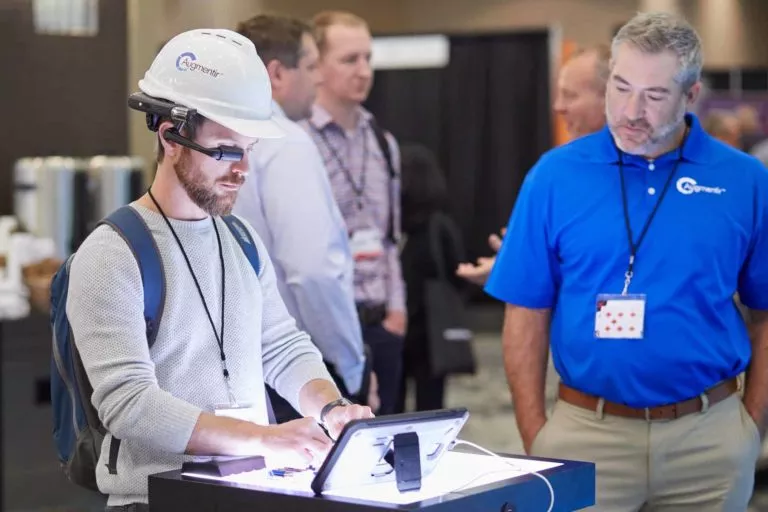
Immersive marketing, such as branded AR lenses, gets ample attention for its potential to transform consumer shopping. But how do these interactive formats translate to B2B marketing? We’re talking everything from enterprise software to heavy equipment sales.
Backing up, the B2B marketing playbook seems written in stone: post semi-frequently on social media, develop thought leadership assets that establish authority, and reach out via common channels like e-mail that, if you’re lucky, won’t end up in someone’s spam folder. While analytics will often tell you if your campaigns were effective, it can be hard not to feel like one minuscule voice trying to break through a cloud of persistent noise.
This is why marketers are constantly on the hunt for new, innovative ways to capture the attention of their B2B audiences – and why new advancements in martech tend to drive so much anticipation. AR and VR could hit that mark by immersing consumers in the world of your making, making them exciting and engaging methods of developing customer experiences.
If you haven’t considered integrating AR and VR into your marketing campaigns, you’re in the right place. Let’s break down this technological phenomenon and how you can use it to craft unique, personalized experiences that keep customers engaged.
B2B XR: a Competitive Imperative?
AR and VR are tools that allow customers to engage with your business indirectly and have a variety of potential use cases that vary from industry to industry. Manufacturers, for example, can use VR to allow would-be clients to attend a remote, immersive tour of the facilities, highlighting clean workspaces, top-of-the-line machinery, and sustainable waste disposal practices.
AR, on the other hand, could be used by construction companies to provide developers with an interactive, 3D visualization of the finished product. Major B2B players like Cisco, Microsoft, and Adobe are already using AR and VR to facilitate better customer experiences for their customers – and B2C brands like Adidas and the New York Times aren’t far behind.
While this technology is still relatively new to the market, it may be that with time, it will also become a standard part of the marketing playbook. Future-proofing by adopting these new technologies allows you to remain competitive in the current market. It’ll also boost your business’s sustainability and longevity, as it can help you pivot towards a more digitally-bent consumer shopping experience. Other measures you can take to future-proof your business include collecting customer feedback, investing in ongoing training for employees, and performing risk assessments.
Analytics and Personalizing Customer Experiences
An often overlooked aspect of AR and VR marketing is its flexibility of experience. While your prospective customers are engaged in the virtual experience you’ve crafted, you can add personal touches backed by data to further drive buying interest and boost conversions.
Think of it like this: the common experience of your virtual tour, 3D model, or companion AR app might remain the same for most consumers. But if you’re armed with the right data concerning your target audience, their interests, and the most likely factors to inspire conversion, you can proactively tweak details of your experience to cater to those factors.
This becomes even easier when AI is part of the experience, as pairing AI with AR and VR technology automates this process, providing personalized experiences without manual preparation. AI’s predictive capabilities and analytical insights come together within the virtual experience to act as a knowledgeable, valuable guide. Distributors, for example, can integrate AI into a virtual tour of their facilities to provide to would-be customers. The AI would answer questions, proactively recommend tour stops, and offer relevant information based on the would-be-partner organizations’ data.
Additionally, harkening back to the competitive imperative we discussed before, AI is also being rapidly adopted by many B2B organizations; pairing it with AR and VR might put you at pace with your competition, if not outright ahead.
XR Campaigns
AR and VR technologies are inherently flexible, and how you use them in your marketing campaign will likely vary based on your target demographics, the industry you work in, and the services you provide. If you’re wondering how your brand can use these technologies in your marketing mix, consider the following:
- What is the value for the customer? How can you use these technologies to shape a unique experience for them, that provides all the knowledge and personal touches of an in-person shopping experience remotely?
- How can you weave insights from data into your experience to make it personal? When you look at your demographic’s data, what do they report wanting from remote/digitally-enhanced shopping experiences? How can you cater to their desires to really stand out as their premier partner?
- What are your competitors up to? Are your competitors using AR and VR in a compelling way? And if not, how can you one-up them by doing it yourself?
AR and VR are powerful marketing tools; we hope this article gave you the insight you need to break free from the standard marketing playbook, future-proof your business, and craft an engaging virtual experience for your potential clients.
 Indiana Lee is a writer who focuses on emerging tech, wellness, and environmental topics.
Indiana Lee is a writer who focuses on emerging tech, wellness, and environmental topics.

